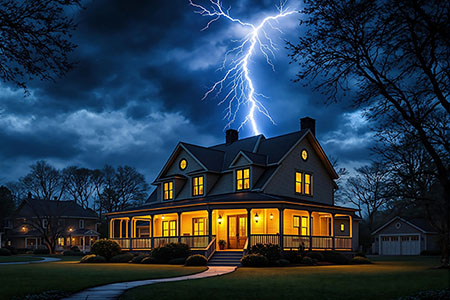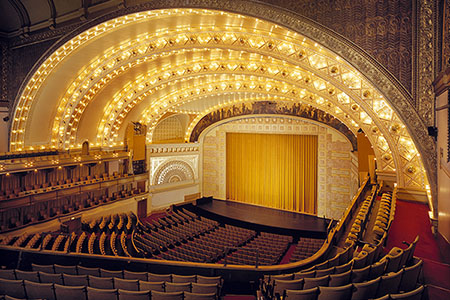Unit owners hear advantages of Marina City landmark status
Jun. 16, 2008 – Although the financial benefits are uncertain, official landmark status would give Marina City residents more control over how the complex looks. About 50 people, mostly unit owners at Marina City, heard this and other advice from three experts on the landmarking process at a meeting on June 16. “Clearly, you have a unique building in the city of Chicago,” said T. Gunny Harboe, an architect whose firm specializes in historic preservation. “It is a landmark by the real meaning of the word. Everyone knows it’s important to the city. It’s a travesty that it’s not officially recognized as an official City of Chicago landmark.” Lisa DiChiera, Advocacy Director of Landmarks Illinois, described the two types of landmarking. Landmark designation by the City of Chicago is more protective, she says, than being listed in the National Register of Historic Places. It would prevent demolition and require additional review whenever changes are needed to the exterior. Following a failed attempt to block Dick’s Last Resort from moving its restaurant and bar to Marina City, a renewed effort to seek official landmark status has been led by officers of Marina Towers Condominium Association. “It’s no secret that a lot of people have become interested in this issue because of Dick’s Last Resort,” said DiChiera. “If this building had already been a City of Chicago landmark, then all of that exterior work would have been more closely reviewed by the city from an aesthetic standpoint.”
But she says protections would apply between the Commission on Chicago Landmarks voting in favor of preliminary designation and the final designation by the City Council. “Chicago landmark designation often can be a very political process. Often, what happens is the alderman becomes engaged. The alderman is asked by building owners if the Department of Planning could evaluate the complex.” They would decide how landmark designation would be done, including what components of the building would be protected. 42nd Ward Alderman Brendan Reilly would try to determine the level of support among Marina City residents for landmarking. “As long as the alderman feels there is a consensus, then it can be pursued.” Advantages to homeowners “There are really two essential reasons why any homeowners are interested in getting landmark designation,” said Victoria Granacki of Granacki Historic Consultants, a historic preservation consulting company. “The first one is to try to control what’s going to happen to the exterior of the property.”
Owner-occupied units would qualify for a freeze on their assessed value for up to 11 years, “The assessed value of the property would be frozen at where it was when work was started, effective for eight years, and then three more years when it is gradually brought back up to where it would be if you hadn’t taken part in the program.” The freeze would not be available to investors who do not live in the unit. To take advantage of the freeze, the changes would have to be approved by the Illinois Historic Preservation Agency. “You have to keep the character of the principal rooms,” says Granacki, “which typically is like the living room or entryway.” As for tearing down walls, “it depends on the individual unit and what the history of changes have been.”
Does landmark designation affect property values? DiChiera says, “Landmark designation…has a slight move of lowering the value of the property, but there’s always going to be a buyer out there for your property. In the case of a complex like Marina City, you’re one of the most prominent, sought-after buildings in downtown Chicago and market values will always remain valuable.” “Landmark designation, my personal feeling is, does not have impact on one’s property values. Often, a lot of people put higher value with properties that are landmarked because they know that property is going to be protected.” And DiChiera points out local landmark designation only covers the exterior of a building. “It doesn’t mean the City of Chicago would be watching what people are doing to the interior of units.” Don’t do it for the money
are owned by a large corporation that probably would rather not have the city saying what they should or shouldn’t do.” He referred to Lasalle Hotel Properties, owner of Hotel Sax and commercial property at Marina City. Landmark designation, the panel said, would have to include the entire complex, both residential and commercial. When asked if support from commercial owners would be required, Granacki replied, “Not necessarily. In the city of Chicago, a landmark can be designated without the owner’s consent.” Harboe emphasized the financial incentives are not guaranteed. “I don’t want to over-play that for you because the reality is, in a building like this, with so many…owners, it’s not an easy thing to do.” Owners, he said, should not seek landmark status solely for the financial benefits. “You should pursue it because you firmly believe this building deserves to be landmarked.” Connection to MTCA board denied Ken Chessick – whose wife, Ellen, is Secretary of Marina Towers Condominium Association and who registered the web site domain of the organization behind the drive for landmark status – denied any connection to the MTCA board of directors. “This is not the board,” he said at the conclusion of the meeting he moderated. “Let me be totally clear. This has nothing to do with the board. The board is restricted by this agreement from taking a position, And they have not taken a position. My wife is on the board. She is not here as a board member. She’s here as an owner, like I am.” A 2003 agreement with commercial owners prohibits MTCA from supporting landmark designation of Marina City. According to public records with the Secretary of State, the not-for-profit Landmark Marina City Now was incorporated by Waveney G. Cameron, who works in the same building and on the same floor as MTCA President Donna Leonard. Says Ken Chessick, “Right now, we’ve got well over the majority of owners who believe this building is an icon that should be preserved.” |

















